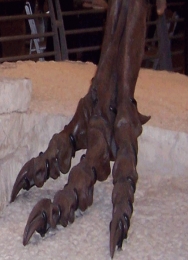Theropods were a group of dinosaurs which were bipedal. While most of them were carnivores, it is believed by some paleontologists that a few eventually became herbivores during the Cretaceous period. Theropods also appeared during the later stages of the Triassic period, which was well over 200 million years ago. Today over 9,000 species of birds are directly descended from them.
 Theropods were the opposite of sauropods in many ways. While the sauropods were large and not very active, the theropods are much smaller and much more agile in comparison. Theropods are similar to birds in the fact they they had three toes, bones which were filled with air, while some even had feathers and built nests for their eggs.
Theropods were the opposite of sauropods in many ways. While the sauropods were large and not very active, the theropods are much smaller and much more agile in comparison. Theropods are similar to birds in the fact they they had three toes, bones which were filled with air, while some even had feathers and built nests for their eggs.
During the late Triassic period, a large number of theropod like dinosaurs evolved. The earliest theropod is a small dinosaur called Eoraptor which existed in what today is known as Argentina. Other types of dinosaurs called Herrerasaurs which lived in North and South America. Eoraptors were small creatures which hunted prey which was small. As they evolved they become larger and more complex.
Theropods preyed on both small and large herbivores. Theropods were divided into four groups, and all survived into the Cretaceous period. Tyrannosaurus was one such theropod which thrived during the Cretaceous period. These animals ran on their hind legs, and some paleontologists believe they hunted in packs, though no evidence has yet been found to support this.
When many people read about the various species of dinosaurs, they become overwhelmed. Despite the many variety of dinosaurs, they are basically broken down into two types, which are separated by the structure of their hips. They are divided into the Ornithischians and Saurischians. All dinosaurs which are carnivores are members of the saurischian family, while most herbivores are members of the Ornithischians family of dinosaurs.
Theropods were fierce creatures, and could hunt their prey effectively. While they were not as large as the sauropods, their speed and agility made them a powerful group of animals which thrived during the Cretaceous period.
